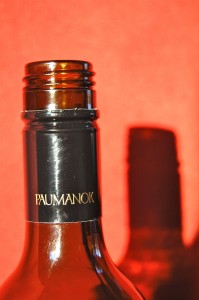
Kareem Massoud, winemaker at Paumanok Vineyards, has a thing for screwcaps. I wouldn’t say that loves them — that’d be kinda weird — but believes in them and loves talking about them. Just trying talking to Kareem for any length of time without alternative closures coming up. It’s damn near impossible.
Kareem, like his father Charles before him, takes a very thoughtful, logical approach to the family’s wines.
“My parents bought this farm in 1983 and planted grapevines on bare land,” he says “Many years were spent establishing the vineyard until the vines bore fruit for the first Paumanok label — a 1989 Barrel Fermented Chardonnay. A turn-key, modern winemaking facility was built. All kinds of capital investments were made — a bottling line, tanks, a grape press, a harvester, etc. Not to mention the human blood, sweat and tears that goes into making it all happen. You go through all this effort only to take a chance that the very last thing you do to the wine can spoil it? When there is a perfectly reliable alternative?”
[pullquote_left]”You go through all this effort only to take a chance that the very last thing you do to the wine can spoil it? When there is a perfectly reliable alternative?”
— Kareem Massoud, Paumanok Vineyards[/pullquote_left]
That rational mindset led the Massoud family to purchase a screwcap bottling line in 2007, which they used in early 2008 to bottle all of the winery’s white wines. Since then, every Paumanok white or pink wines has been bottled under screwcap — everything from the $17 Festival Chardonnay up through the $36 Grand Vintage Chardonnay.
Even the most staunch natural cork advocates will grudgingly concede that screwcaps can be appropriate white wines (and rose) intended to be consumed early and fresh. But for many, the jury is still out on when it comes to closing red wines under Stelvin.
The Massouds took have taken and continue to take their time with making that decision and transition as well.
“10-15% of all of the 2007 reds were bottled under screw cap,” Kareem told me. “The 2008 Festival red was the other way around, over 90% screw cap and the remainder under cork. The 2009 Festival Red was 100% screw cap.”
Bottling Festival Red, an under-$20 drink-now blend , under Stelvin is one thing, but Kareem didn’t stop there. Since 2007 he’s bottled most of his reds under both standard natural cork and Stelvin, with the percentages varying from year to year so he can track their progress and also offer both options to his customers.
But starting with the 2010 vintage — all of the standard, non-Grand Vintage reds (known as “white label” wines to many) will be bottled entirely under screwcap.
“In addition, the majority of the 2010Assemblage will be sealed under screw cap,” Kareem said.
The decision to bottle so much of the winery’s high-end Bordeaux-style blend mostly under Stelvin closures, was the result of regular side-by-side tastings of the 2007 Assemblage under each closure.
“The Stelvin-finished wine was more exuberant, brighter, more youthful and well-preserved in its character,” Kareem said “The cork-finished wine showed well too — they are both the same exact wine after all — but was more developed. This is all the more remarkable as I added an additional 10 part per million of sulfur dioxide to the cork-finished wine. So even though the screwcap-finished wine had less preservative added to it, it still tasted more youthful than the cork finished wine. ”

